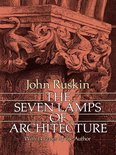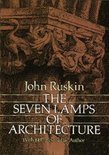The Seven Lamps of Architecture
Afbeeldingen
Sla de afbeeldingen overArtikel vergelijken
Uitgever: Createspace Independent Publishing Platform
- Engels
- Paperback
- 9781497579835
- 09 april 2014
- 112 pagina's
John Ruskin
Samenvatting
In August of 1848, John Ruskin and his new bride visited northern France, for the gifted young critic wished to write a work that would examine the essence of Gothic architecture. By the following April, the book was finished. Titled The Seven Lamps of Architecture, it was far more than a treatise on the Gothic style; instead, it elaborated Ruskin's deepest convictions of the nature and role of architecture and its aesthetics. The book was published to immediate acclaim and has since become an acknowledged classic.
The ''seven lamps'' are Sacrifice, Truth, Power, Beauty, Life, Memory, and Obedience. In delineating the relationship of these terms to architecture, Ruskin distinguishes between architecture and mere building. Architecture is an exalting discipline that must dignify and ennoble public life. It must preserve the purity of the materials it uses; and it must serve as a source of power and renewal for the society that produces it. The author expounds these and many other ideas with exceptional passion and knowledge, expressed in a masterly prose style.
Today, Ruskin's timeless observations are as relevant as they were in Victorian times, making The Seven Lamps of Architecture required reading for architects, students, and other lovers of architecture, who will find in these pages a thoughtful and inspiring approach to one of man's noblest endeavors.
This authoritative edition includes excellent reproductions of the 14 original plates of Ruskin's superb drawings of architectural details from such structures as the Doge's Palace in Venice, Giotto's Campanile in Florence, and the Cathedral of Rouen.
Productspecificaties
Inhoud
- Taal
- en
- Bindwijze
- Paperback
- Oorspronkelijke releasedatum
- 09 april 2014
- Aantal pagina's
- 112
- Illustraties
- Nee
Betrokkenen
- Hoofdauteur
- John Ruskin
- Tweede Auteur
- John Ruskin
- Hoofdredacteur
- The Perfect Library
- Tweede Redacteur
- The Perfect Library
- Hoofduitgeverij
- Createspace Independent Publishing Platform
Overige kenmerken
- Extra groot lettertype
- Nee
- Product breedte
- 152 mm
- Product hoogte
- 6 mm
- Product lengte
- 229 mm
- Studieboek
- Nee
- Verpakking breedte
- 152 mm
- Verpakking hoogte
- 6 mm
- Verpakking lengte
- 229 mm
- Verpakkingsgewicht
- 159 g
EAN
- EAN
- 9781497579835
Je vindt dit artikel in
- Categorieën
- Taal
- Engels
- Boek, ebook of luisterboek?
- Boek
- Studieboek of algemeen
- Algemene boeken
Kies gewenste uitvoering
Prijsinformatie en bestellen
Alle bindwijzen en edities (4)
-
0,49Direct beschikbaar
-
14,69Direct beschikbaar
-
10,79Uiterlijk 16 mei in huis
Levertijd
We doen er alles aan om dit artikel op tijd te bezorgen. Het is echter in een enkel geval mogelijk dat door omstandigheden de bezorging vertraagd is.
Bezorgopties
We bieden verschillende opties aan voor het bezorgen of ophalen van je bestelling. Welke opties voor jouw bestelling beschikbaar zijn, zie je bij het afronden van de bestelling.
Tooltip -
46,902 - 3 weken
Levertijd
We doen er alles aan om dit artikel op tijd te bezorgen. Het is echter in een enkel geval mogelijk dat door omstandigheden de bezorging vertraagd is.
Bezorgopties
We bieden verschillende opties aan voor het bezorgen of ophalen van je bestelling. Welke opties voor jouw bestelling beschikbaar zijn, zie je bij het afronden van de bestelling.
Tooltip
Rapporteer dit artikel
Je wilt melding doen van illegale inhoud over dit artikel:
- Ik wil melding doen als klant
- Ik wil melding doen als autoriteit of trusted flagger
- Ik wil melding doen als partner
- Ik wil melding doen als merkhouder
Geen klant, autoriteit, trusted flagger, merkhouder of partner? Gebruik dan onderstaande link om melding te doen.




